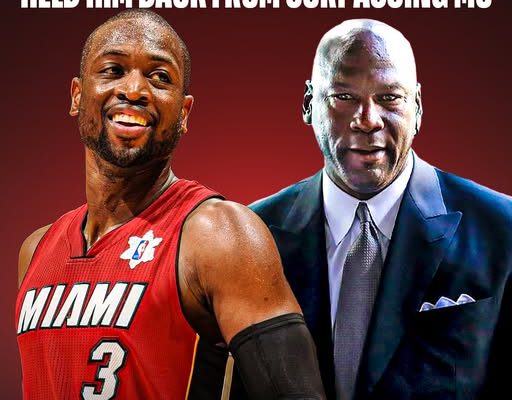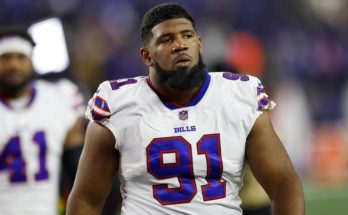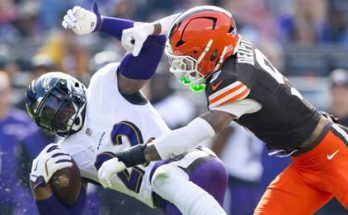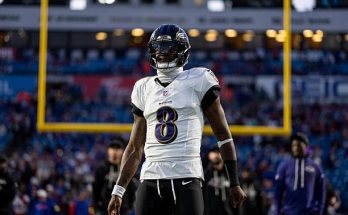Dwyane Wade’s journey through the NBA was one of brilliance, resilience, and undeniable greatness. From the moment he was drafted fifth overall by the Miami Heat in 2003, it was clear that Wade was built differently. He wasn’t just another guard entering the league; he was a fierce competitor who would stop at nothing to carve his name among the all-time greats. Over the years, his confidence became one of his defining traits. He didn’t shy away from lofty goals or comparisons, and at one point, he genuinely believed he could catch the standard-bearer of basketball greatness, Michael Jordan. For Wade, this was not just wishful thinking—it was rooted in the remarkable trajectory of his early career, his work ethic, and his hunger for success. Yet, as his story unfolded, one major factor stood in the way of him reaching the level of Jordan: injuries.
In the early stages of his career, Wade was nothing short of electrifying. His combination of speed, strength, and fearlessness when attacking the rim earned him the nickname “Flash,” and it didn’t take long for him to show the world why. By his third season in the league, Wade had already cemented his place as one of the top players in the NBA. In 2006, at just 24 years old, he led the Miami Heat to their first-ever NBA championship, winning Finals MVP in the process. His performance against the Dallas Mavericks in that series was legendary—34.7 points per game, relentless drives to the basket, and an unwavering will to win. At that moment, it was fair to wonder how far Wade’s talent and determination could take him. Many fans and analysts began to talk about his potential to enter the conversation as one of the greatest shooting guards of all time. Wade himself, a player who always believed in setting the bar high, was confident that with continued success, there was no ceiling to what he could achieve.
Michael Jordan, widely regarded as the greatest basketball player ever, was the ultimate measuring stick. Jordan’s six championships, five MVPs, and countless iconic moments made him the standard that every aspiring legend aimed for. Wade, like many others, grew up idolizing Jordan, modeling parts of his game after him, especially the mid-range footwork and fearless mentality in the clutch. But unlike most players who admired Jordan from a distance, Wade had the self-belief to think he could rival that greatness. After winning his first championship and showing no signs of slowing down, the idea of catching up to Jordan—at least in terms of championships—didn’t feel completely outlandish. Wade was just getting started, and he had the skill set and mental fortitude to back up his ambitions.
However, the physical demands of Wade’s style of play began to catch up with him earlier than anyone expected. Known for his aggressive drives to the basket, Wade played a brand of basketball that put his body on the line night after night. He attacked the rim fearlessly, absorbing contact from bigger defenders and often hitting the floor hard after finishing plays. While this approach made him one of the most exciting players to watch, it also meant that his body took a significant beating over time. By his mid-20s, Wade was already dealing with nagging injuries, particularly to his knees and shoulders. These injuries would become a recurring theme in his career, robbing him of stretches of prime athleticism and, ultimately, altering the trajectory that could have put him closer to Jordan’s level of sustained dominance.
Despite the setbacks, Wade continued to produce elite-level basketball. His 2008-09 season is often cited as one of the best of his career. After battling injuries in the prior seasons, Wade came back with a vengeance, leading the league in scoring with 30.2 points per game and finishing third in MVP voting behind LeBron James and Kobe Bryant. It was a reminder of just how talented and relentless Wade could be when healthy. He could dominate games on both ends of the floor, and he had a championship pedigree that few could match. Still, the lingering question was always about his durability. While Jordan was known for his ironman approach, playing all 82 games multiple times in his career and maintaining peak performance for over a decade, Wade’s body simply couldn’t sustain that kind of load year after year.
One of the biggest what-ifs in Wade’s career revolves around the prime years that were hampered by injuries. Had he been able to stay consistently healthy, there’s little doubt that he would have added to his championship total, statistical milestones, and overall impact on the game. By the time LeBron James and Chris Bosh joined him in Miami to form the iconic “Big Three,” Wade’s knees were already showing significant wear and tear. While he still played at an elite level and was instrumental in Miami’s back-to-back championships in 2012 and 2013, he was no longer the same unstoppable force he had been earlier in his career. Instead, he adjusted his game, taking on a less physically demanding role to allow LeBron to shoulder much of the load. This selflessness paid off in terms of team success, but it also meant that Wade’s personal accolades and statistics didn’t reach the heights they might have if he had remained the focal point of the offense.
Jordan’s greatness is defined not only by his skill and championships but also by his ability to maintain a standard of excellence for so long. Wade, for all his talent and heart, simply didn’t have the luxury of a body that could endure that same level of grind without consequence. By his early 30s, Wade’s game had evolved out of necessity. He relied more on mid-range jumpers, post-ups, and basketball IQ rather than explosive drives to the rim. While he was still highly effective, the injuries had already created a gap between him and the lofty goal of catching Jordan. Wade himself has admitted in interviews that injuries were the one thing he couldn’t control, and they played the biggest role in limiting how far he could go in the debate for all-time greatness.
Even with these limitations, Wade’s legacy remains extraordinary. He retired as a three-time NBA champion, a 13-time All-Star, an eight-time All-NBA selection, and one of the best players in Miami Heat history. His impact on the franchise and the league as a whole is undeniable. Wade’s blend of humility, leadership, and competitive fire made him a beloved figure not only in Miami but across the NBA landscape. In many ways, his willingness to adjust his game, accept a secondary role when needed, and still find ways to win speaks volumes about his basketball IQ and team-first mentality.
Catching Michael Jordan was always going to be an almost impossible challenge for any player, but Wade’s belief in himself is part of what made him so special. He set the highest standards and came remarkably close to achieving them despite the hurdles he faced. In a different timeline, where injuries didn’t take such a toll, perhaps the conversation would have been different. Maybe Wade would have added a few more championships, a couple more scoring titles, and a stronger case as one of the top two shooting guards of all time, right alongside Jordan and Kobe Bryant. But basketball, like life, is rarely a straight path. For Wade, the adversity he faced only added to the respect he commands today.
While Wade might not have caught Jordan statistically or in terms of championships, he carved out a unique and celebrated place in NBA history. His career serves as a reminder that greatness is not always measured by surpassing someone else’s accomplishments, but by maximizing your own potential and leaving a lasting impact. Wade did exactly that, and though injuries may have prevented him from reaching the ultimate goal he once envisioned, they never dimmed the legacy of one of the most dynamic and beloved players the game has ever seen.



